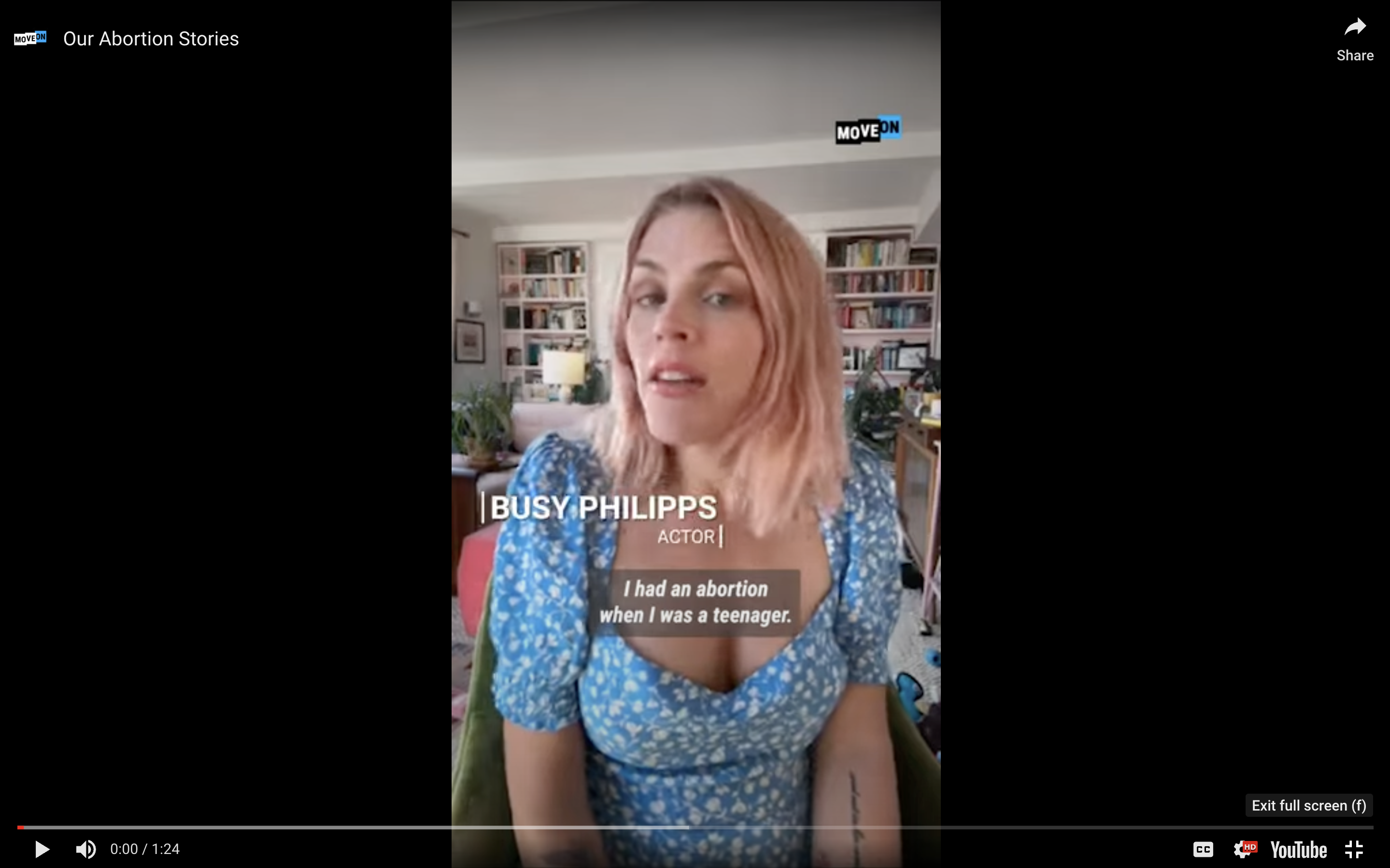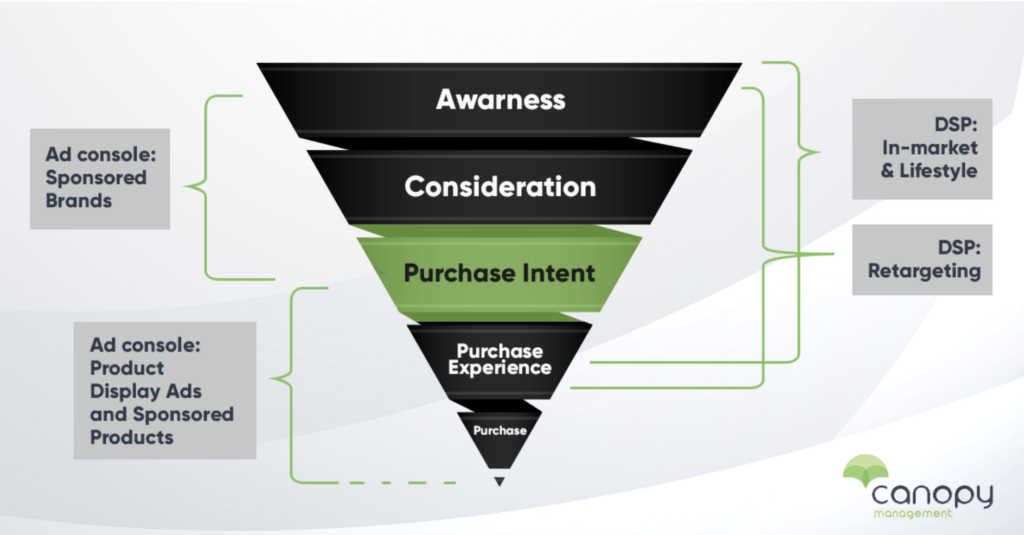Running and managing successful PPC campaigns require much more than an advertising budget. It also involves endless hours of activities like keyword research, competitive analysis, ad optimization, split testing, and performance tracking. Amazon PPC management requires a unique blend...
Running and managing successful PPC campaigns require much more than an advertising budget. It also involves endless hours of activities like keyword research, competitive analysis, ad optimization, split testing, and performance tracking.
Amazon PPC management requires a unique blend of skills, tools, and eCommerce experience to be able to run a profitable PPC campaign. More importantly, they’re a crucial part of why businesses are able to achieve their advertising goals and maximize their ROI.
Fortunately, you don’t need an advanced degree in Amazon marketing to become an expert or manage your PPC campaign. There are endless learning resources and tools that can help you achieve results quickly. However, you must be willing and able to apply what you’ve learned to your daily Amazon PPC management tasks and build your experience as you progress.
Are you looking to start a career in Amazon PPC or simply want to level up your own Amazon advertising? This guide has everything you need to kickstart your PPC ad journey and begin your journey to becoming an Amazon SEO expert.
Want to HIRE an Amazon PPC Expert Today?
CANOPY’s Partners Achieve an Average 84% Profit Increase!
Let’s talkUnderstanding the Fundamentals of Amazon PPC
The first step to becoming an Amazon PPC management expert is understanding the basics of Amazon advertising.
Amazon is a very competitive marketplace with millions of sellers. Amazon’s advertising solutions enable marketers and sellers to boost visibility, increase sales and stay ahead of the competition.
Like other digital networks, Amazon marketing and advertising revolves around a Pay-Per-Click (PPC) model where marketers pay when potential shoppers click on their ads.
Before Amazon launched PPC advertising in 2012, an Amazon PPC agency might have relied on search engine optimization (SEO) to boost visibility. Today, your Amazon SEO is still crucial for improving your product ranking, but PPC on Amazon delivers faster results for brands and marketers.
With the right Amazon PPC strategy, you can improve visibility, attract the right customers and increase conversions. Overall, marketers and businesses rely on PPC to increase sales and drive business growth.
Amazon PPC advertising may appear simple. However, it goes beyond creating a professional seller account, logging into Amazon Seller Central and throwing some dollars into the mix. You need an Amazon campaign management strategy and a developed advertising skill set to run successful campaigns.
What Does an Amazon Expert Do?
Because PPC advertising has the potential to deliver a high return on investment (ROI), PPC experts are in high demand. That’s because they have the tools, expertise, and experience to maximize campaign budgets and achieve results.
PPC experts can help an Amazon seller improve their advertising effectiveness in many critical ways.
Amazon PPC experts:
Set goals and design strategies for Amazon PPC ad campaign execution Research profitable and high-ranking keywords relevant to business and industry Leverage negative keywords to minimize ad spend Create or optimize ad copy to improve conversions. Measure digital marketing campaign performance and analyze competitors’ activitiesTypes of Amazon PPC Ads
As an Amazon PPC management expert, you’d be working either on your own Amazon campaign, or with clients on their particular business needs, advertising goals, and budgets. So it’s imperative to fully understand the different types of Amazon PPC ads and the best scenarios to use them in your ad group.
Let’s review the three types of Amazon PPC ads for marketers, sellers, and brands:
1. Amazon Sponsored Product Ad
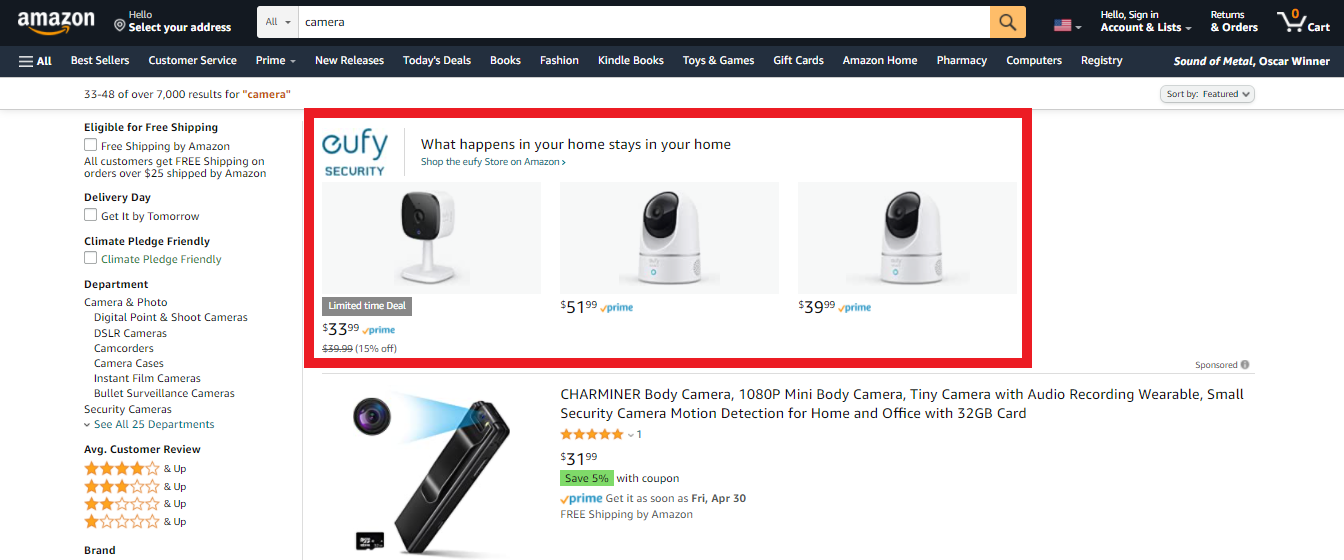
An Amazon Sponsored Product Ad is the most common type of PPC ad. These ads appear in shopping results or product pages and help sellers boost their product visibility and sales.
When you launch an ad campaign, Amazon shows your ads to shoppers searching for similar products as yours. Their advertising algorithm automatically targets buyers or serves ads to customers based on products and shopping queries.
Sponsored Product Ads typically show product title, product images, star ratings, and the Amazon Prime badge.
Because these ad elements appear at the right place (and time), they can entice potential buyers to take a closer look at the product.
With Sponsored Product Ads, you can choose your preferred targeting options, campaign budget, and bids. And if you want to drive product awareness or boost sales for your new product, this ad type is a perfect fit.
Sponsored Product Ads are available for book vendors, brands, professional sellers, agencies and Kindle Direct Publishing (KDP) authors.
2. Amazon Sponsored Brand Ad
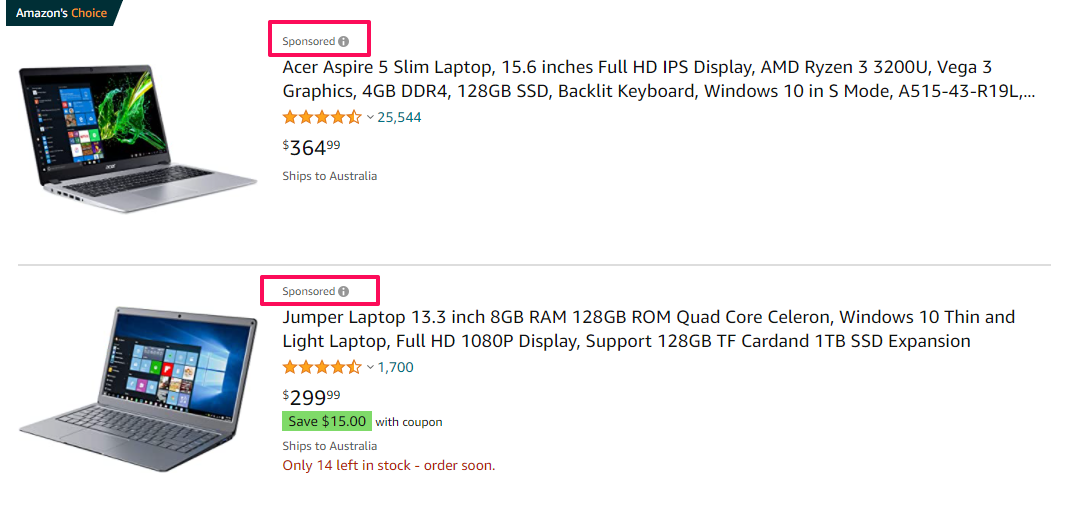
Sponsored Brand Ads are great for merchants and brands that have a comprehensive portfolio of products. This ad type lets businesses increase visibility and increase sales for their brand and multiple products.
Sponsored Brand Ads appear in customer shopping search results. They also feature your brand logo, headline, and a full range of your products. Clicking on the brand logo redirects customers to your store to find other products they are interested in. Similarly, clicking on any product in the ad redirects customers to the product page.
For established brands, Sponsored Brand Ads serve multiple purposes. They help businesses target new buyers, retain existing customers or improve brand recall. A bigger portfolio of “branded” products also helps drive social proof.
Many times, companies use this ad type to drive sales for a larger number of different products. Using Sponsored Brand Ads you can easily introduce your customers to other products they didn’t know about.
Sponsored Brands Ads helps users compile and filter data. For example, “what’s the total number of first-time customers” or “the number of total first-time sales their brand has earned on Amazon in the last year.”
Sponsored Brands Ads are available for book vendors, brands, agencies, professional sellers who have enrolled in Amazon Brand Registry.
3. Amazon Sponsored Display Ad
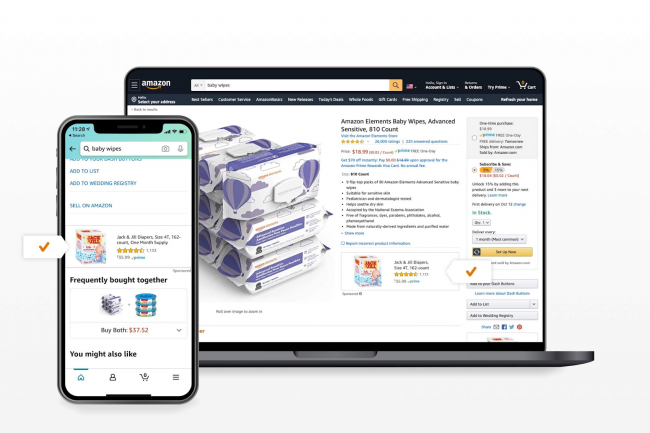
There comes a point when Amazon merchants consider leveraging external traffic as a strategy to expand their customer base. This approach not only increases their visibility but also provides a chance to enhance their email marketing efforts.
If you want to engage audiences on OR OFF Amazon, a Sponsored Display Ad is the perfect ad type. The powerful thing about using this ad type is that you can show your products to customers even after they’ve left Amazon’s ecosystem.
Industry professionals agree that Amazon’s algorithm favors those who direct outside traffic to their marketplace, offering them extra ranking advantages. With Amazon now incentivizing sellers for this, it’s increasingly apparent that nurturing off-Amazon traffic is a smart move for clever eCommerce entrepreneurs.
How many Amazon sellers are really taking full advantage of this opportunity?
Sponsored Display Ads appear on the Amazon home page, product detail pages, shopping result pages, and third-party apps and websites. However, you must have a Featured Offer or products in stock for your ads to appear. Marketers and brands use this ad type to boost brand visibility across multiple sales channels.
Sponsored Display Ads supports three audience targeting options.
Product Targeting
This targeting option lets you engage audiences who are checking out products or categories similar to yours.
Amazon Shopping Interest
This targeting option allows marketers to engage audiences whose buying activity and behavior shows they might have interest in their products.
Views Remarketing
With this targeting option, you can re-engage audiences who have previously viewed your product detail page or that of similar products and categories.
Sponsored Display Ads are available to professional sellers who have enrolled in Amazon Brand Registry agencies and vendors.

Choosing the Right Keywords for Your PPC Campaign
Keywords are search terms or phrases that customers use to look for products on Amazon. Using relevant and profitable keywords boosts your ranking and lets users find your ads when they search Amazon using those search terms.
With pay per click advertising, keywords are what connects the shopper with your listing.
Amazon supports multiple keyword match types. So you can select the one that provides maximum exposure and ranking for your products.
Broad Match
Broad match keywords offer broad ad exposure. And your ad will appear if it contains the phrase, keyword terms, or close variants. For example, keywords like “baseball caps:” will show your ads for search terms such as:
Baseball caps Purple baseball caps Discount baseball cap Purple cap for baseballPhrase Match
This match type is more restrictive compared to the broad match type. Your ads will appear when buyers search for the exact keyword or keywords with additional words before or after it.
From the example using “baseball caps,” your ads will appear for searches such as:
Baseball caps for men Yellow baseball capsExact Match
Your ads will only appear if your keywords match the customer search term. So if your customer is searching “baseball caps,” your ad will appear for the term “baseball caps” only.
Negative Keywords
Negative keywords prevent your ads from showing when customers use those search terms. Like keywords, negative keywords are divided into
Negative broad match Negative phrase match Negative exact matchWhy would you need to use negative keywords in your ads?
Negative keywords allow you to target customers who are likely to convert, by specifically avoiding customers unlikely to convert.
Negative keywords can literally prevent them from even seeing your ad. With this level of control, you can save advertising costs and only pay for clicks that drive sales.
Not taking full advantage of negative keywords can lead to your ads being shown for unrelated searches, leading to low click-through rates, weak conversions, and increased ACoS.
This causes Amazon to lose “confidence” in your product, and precipitates a flywheel effect that in turn leads to a lower ranking, less visibility, and even fewer sales.
Amazon is all about customer service. Your product being shown to uninterested shoppers makes Amazon look bad, and guess who is going to be held responsible?
That’s right! When that happens, you can say goodbye to your Amazon product ranking.

Keyword Research and Analysis
Amazon SEO is critical to long-term success on the platform, and keyword research is an essential piece of the puzzle.
There’s no doubt that using relevant keywords for your PPC campaigns is essential. Of course, you can’t just make wild guesses. Your keyword choice should be backed by historical data such as ranking, relevancy, search volume, and cost per click.
That’s why many Amazon PPC experts and PPC management agencies take advantage of sophisticated tools to find relevant, profitable, and high-ranking keywords that will drive your campaign to the next level.
Although Google’s Keyword Planner tool may be a good place to start your research, you won’t get in-depth keyword data. Experienced Amazon PPC management experts use tools from SaaS (Software as a Service) companies such as Helium 10 and Jungle Scout to start this process.
Using keyword search tools you can:
Perform intensive keyword research to find high-volume keywords based on relevance and search queries. Discover search terms or keywords that customers are using to find your products so you can optimize your listings for your target audience. Identify best and worst-performing keywords to eliminate wasted ad spend.Writing Ad Copy That Drives Conversions
Writing ad copy is an essential skill set for Amazon PPC experts. Because you’ll be writing thousands of ads for your clients, it is crucial to be familiar with Amazon ad copy guidelines and policies.
Your ad may be your shopper’s initial contact with your brand. So, it should be compelling enough to attract clicks and drive conversions. Otherwise, you may end up paying for clicks that are not converting.
Here are some tips to help you create compelling ad copy:
Your headline, title, and description should be clear, concise, and accurate. Your customers should find every single piece of information they need to make a purchase. Use high-quality and high-resolution images in your ads. Remember that’s the only visual experience your customers have before purchase, so it should be appealing enough to compel them to click the Buy Button. . Write a clear, direct, and powerful call-to-action that induces buyers to take action with phrases such as click, and add to cart.
Explore Different Bidding Methods
Like other PPC ad types, Amazon advertising operates an auction system where marketers bid the maximum amount they are willing to pay when buyers click an advertisement for their product. So after creating a compelling ad copy and an optimized product listing, your job isn’t done yet.
Your first big decision is to choose a bidding strategy that will help you achieve significant sales results. You may choose to launch your manual campaign or let Amazon automatically manage and adjust your bids.
Other merchants are selling similar products to yours. So, your bid must be competitive enough to increase your chances of getting your ad to the top of shopping search results.
However, there isn’t a one size fits all approach to Amazon PPC advertising or bidding.
Many beginning advertisers begin with the automatic bidding option. Amazon uses AI and complex algorithms to optimize the bid to help achieve advertising goals. In such cases, Amazon increases or decreases the bid based on the likelihood of conversion. This option minimizes ad spend and ensures that advertisers pay for clicks that will result in sales.
Because Amazon doesn’t adjust manual bids, you may end up paying more money just for a few clicks. However, experienced Amazon sellers can take advantage of manual bids as a solid strategy to gain a top spot if your niche is very competitive.
Beyond manual and automatic bids, merchants can adjust bids based on various placements, including:
Top of search (first page) Product detail pages Rest of searchAs mentioned earlier, when it comes to a recipe for success, with PPC on Amazon, no bidding strategy supersedes any other. You may need to use a combination of bidding strategies to achieve significant results.
Understand the Metrics and Track Results
When you truly understand the valuable data and underlying metrics, you’re better able to create efficient, money-making listings that help you stand out from the crowd.
Keeping an eye on your metrics is critical if you want to achieve Amazon PPC campaign success. Metrics help you analyze your ad spend and measure advertising effectiveness. They also provide deeper insights into the different aspects of your campaign that you can adjust to increase sales.
Amazon Campaign Manager provides detailed reporting data to help you analyze ad spend and track return on investment (ROI).
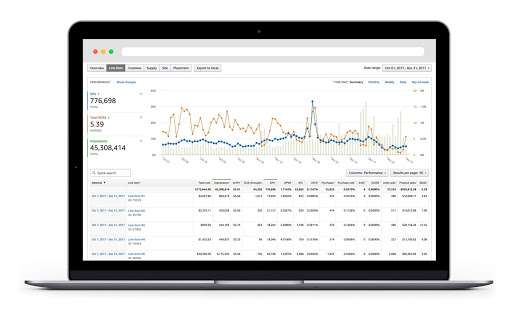
The following is a list of some of the metrics that can help you measure campaign performance:
Budget Bid Detail page views (DPV) Cost-per-click and cost per impression Advertising cost of sales Click-through rate Conversions New to brand metrics Impressions Returns on ad spend (ROAS) Return on investment (ROI)Keep Up With Industry Trends and Product Updates
As an Amazon PPC expert, you’ll want to keep up with the latest trends related to your niche, product category, or industry. Otherwise, you’ll be left behind.
You should be willing to read product updates, monitor sales trends and patterns, attend sales events and webinars, and read online news and journals. Working with your own Amazon brand, or with clients means you have to get your hands dirty by monitoring trends, tweaking campaigns, and bidding strategies to drive in more sales.
For instance, Amazon product sales for winter coats may spike due to freezing temperatures. Such events may represent an opportunity for you or your clients to make more sales. However, you will need to plan ahead and update your inventory, then adjust your bid or targeting strategy to reach shoppers in that region.
Get Inspired by Competitors
Keeping an eye on the competition is a critical activity for any business. There’s always a lot to learn from competitors.
To learn from them, you need to track their activities and thoroughly understand their overall approach. You can leverage this knowledge to develop and sustain a competitive advantage that always keeps you one step ahead of your competitors.
Whether you are a new or veteran Amazon seller, there are many other brands selling similar products. That’s why you need to perform competitive analysis to edge competition.
The first phase of your competitive analysis will help you identify your major competitors and their campaign strategy. Further investigation will provide valuable insight into:
Search terms and keywords that are driving more sales for your competitors Best-performing, worst-performing, and underutilized keywords Keyword search volumes and ranking Product pricing. ad copy, ad placements, reviews.The goal is to identify competitive gaps, and rank for profitable keywords that your competitors are not using. By doing that you can increase sales and achieve a positive ROI.

Putting In the Work
The ability to manage Amazon PPC campaigns is a significant lever for businesses hoping for the highest level of eCommerce success. With the right set of tools and skillset, you’ll be able to maximize campaign budgets and achieve a high return on ad spend.
More than just setting up your PPC campaigns, expert Amazon PPC management means optimizing campaigns, tracking ad spending, and monitoring performance. It will also include the A/B testing of different ad elements and strategies to determine which combination works for the brand or business.
This blog post detailed the steps that you want to take to become your own pay per click management expert. Unfortunately, many of you won’t be able to dedicate the time necessary to COMPETE against those who have taken a lucrative shortcut; HIRING Amazon PPC experts.
Outsourcing your Amazon PPC management to an Amazon PPC agency allows you to step back, manage your entire eCommerce business, while at the same time, taking advantage of the sales velocity that comes from making sure your Amazon advertising campaign is set up perfectly.
How Canopy Management Can Help
Canopy Management is a full-service marketing agency for Walmart and Amazon sellers. Our team consists of former Amazonians, multi-million dollar sellers, and award-winning experts.
When you consider the many ways that Canopy Management can help you grow your business, you’ll see why selling on Amazon is much easier “under the Canopy”:
Strategic Growth Planning Listing Copywriting Optimization Listing Photography Product Videography Advertising Management Customer Service Demand Side Platform (Amazon DSP) Amazon Posts Full Service Management Amazon Review AggregationReady to Level Up Your Amazon Business?
Start applicationThe post How to Become an Amazon PPC Management Expert in 2024 appeared first on Canopy Management.



